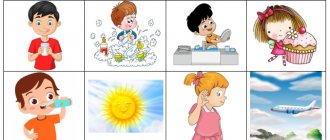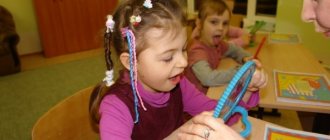Publications on speech therapy
Goals:
1) clarifying the semantics of prepositions;
2) consolidate knowledge about prepositions at a practical level; 3) consolidating the use of prepositions in oral speech; Equipment:
pencils, diagram, punched cards, pens, notebooks, demonstration material.
1. Organizational moment.
The speech therapist invites students to come up with one sentence of 1-2-3 words.
2. Preposition as an independent word.
The speech therapist asks students to complete the following tasks.
Place the pencil on the notebook. Put the pencil in the notebook. Place a pencil under your notebook. Put down the pencil…..book. The speech therapist explains: “You are finding it difficult to complete the last task only because I missed one little word. Guess what word I missed." The speech therapist then continues, “Put your pencil on the book. (The task is being completed.) Put down the pencil….book. What words are missing? (On the)". Then the same tasks are repeated, but prepositions are not named. Students name the missing preposition each time. Why are prepositions needed?
To construct a sentence correctly, you need to remember small but very important words, without which the sentence loses its meaning.
These words are called prepositions. Guys, guess what the topic of our lesson is? Prepositions What prepositions do you know? Simple - by, in front of, with, from, about, on, behind, at, under, with, to, over, in, from. Complex - (0 (about), (about), between, around, before, for, without, because of., through, near, from under, through, about 3. Consider the diagram, answer the questions? Where is the ball
? ?
4. Assignment.
Near each house, write down a preposition corresponding to the picture.
5. Using a poem to remember the rule. We can put it ON the table, We can put it UNDER the table, We can sit AT the table- Separately write “TABLE!”
If they dictate to us: ON THE TABLE- Here we will write two words: ON THE RIVER, ON THE LAKE, ON THE MOUNTAIN - We separate the preposition again.
There are flowers on the window In pots, ON the table There is water in the decanter, There are black dots on the leaf - Always separate prepositions! 6.
Insert prepositions into sentences.
(Before reading, do an exercise on the strength of your voice)
The handkerchief is in ____ pocket. The kettle is boiling ____ the stove. Katya _____brother drank juice. Fish soup is cooked ___fish. The grandchildren came to ___grandmother. The snake crawled ____the ground. The boy hid ___tree. Smoke is coming from ______ pipes. Mushrooms grow ____ forest. The boy is standing ____the bridge. The granddaughter came ____grandmother. The dog ran away ____the owner. The children played ___ hide and seek
Physical education minute.
7. Make sentences from these words.
The ducks sat on the lake. Mushrooms are collected in a basket. Mom went for a walk with her daughter. Cucumbers are ripening in the garden. Products are bought in a store. There are large puddles on the road. The pies were taken out of the oven. Cars are driving along the road. Kolya walked up to the house. There were apples hanging on the branches. The cat ran after the mouse. There is a picture hanging on the wall.
8. Parse the sentences.
Comparison of Russian and Nenets languages. a) The child is sitting on the sled.
(Child sit on the high sledge) Ңatseky khan, ninya ңamdy.
b) The thimble is in the bag.
(The thimble lies in a beautiful bag.) Gumbya cloud.
munya ңa,. c) Mom hid behind the tent.
(Mom hid behind the summer tent.) Nebyami myad, tyakha lyngarey,,.
9. Correct Carlson's mistakes.
Mom and her daughters went for a walk.
The hat flew off my head. The cat jumped off the roof. The ball rolled downhill. A cat with kittens laps milk. Svetka flew off the plane. 10. Exercise.
Open the brackets. (U) ducklings swam, (u) kittens ran, (u) rabbits galloped, (u) eagle (u) eaglets flew.
(from) the little hare jumped (from) the birch tree. (from) the eaglet flew (from) the nest. (from) the children ran (from) the path. The water came (from) the shore.
11. Summary of the lesson.
— 05/11/2013 (23:14) Author Yulia Timofeevna Kolesnik
yuly-kolesnik[@]yandex.ru
Speech therapy lesson notes for 2nd grade
Summary of GCD in 2nd grade on the topic “Prepositions”
Description of the material: I offer you a summary of a speech therapy lesson for 2nd grade students on the topic “Prepositions”. This material will be useful to primary school teachers and speech therapists. This summary is aimed at activating and expanding vocabulary, improving the lexical and grammatical structure of speech, and developing an idea of the semantic meaning of prepositions. Goals: -to improve the lexical and grammatical structure of speech; - form an idea of the semantic meaning of prepositions, a preposition as a separate word, the skill of prepositional management. Objectives: educational: - develop an understanding of the spatial meaning of the prepositions IN, ON, FROM, UNDER, TO, FOR; - work on the correct use of prepositions in oral speech; - develop the ability to correctly divide sentences into individual words; - lead to practical mastery of the correct spelling of prepositions with words - expand and activate the vocabulary on the topic “Wintering birds”. developing: - develop memory, attention, thinking; - Expand words knowledge; — improve the lexical and grammatical structure of speech; - develop monologue speech; - teach children to express their thoughts correctly and logically; - develop the child’s visual-spatial concepts and the semantic meaning of the use of prepositions. educational: - cultivate a culture of communication; — to form mutual understanding, goodwill, independence, initiative, and cooperation skills. correctional: -elimination and prevention of errors in writing, when writing prepositions with words. Equipment: cards with words, subject pictures with birds, cards with tasks for each student, circles for reflection.
Progress of direct educational activities:
1. Introductory part.
Organizing time. -Read the motto of our lesson. “Great success begins with little luck.” - I wish you good luck. 2. Main part. Determining the topic, setting lesson goals. - Guess what we will work on today in class. - Read the words written on the board. object shovel weight - Let's emphasize the first syllables in the words. What did we get? (word prepositions). - What do we know about prepositions? What prepositions do you know? Look for helpers in the classroom. (Children look for excuses). on above between below on the board: Snowflakes are spinning in the transparent air. The boys are skiing. The tit flew to the feeder. — Read the entry on the board. What can you say? (not enough prepositions). Let's try to restore the proposals. — What time of year are these proposals dedicated to? (winter). Prepositions are needed, you can’t do without prepositions. I have a poem that will help us once again generalize our knowledge about prepositions. He is not a member of a sentence, but this guy knows the matter well. Doesn't change, can't live alone, But I didn't want to be friends with verbs. He gives helping hands to words, helps them, takes care of connections. And it is always written separately from the words. He considers pestering them very bad. 3. Graphic dictation. (Restored sentences). - Let's write down the sentences graphically. Instead of the word, draw - , instead of the preposition v . Group work (One of them studies at the blackboard, the rest in notebooks). 4. Physical exercise. Place your hands on your belt. Look at the elbow of your right hand, at the elbow of your left hand. Extend your arms forward. Inhale, raise your arms up, watch your fingertips. Lower your arms and exhale. 5. Consolidation of knowledge, development of vocabulary, coherent speech. - Look, guests have arrived. Who is this? (birds). — What groups do you think they can be divided into? (migratory and wintering). Name the migratory birds, and now wintering ones. We will remove migratory birds. —What is worse for birds, cold or hunger? — How should we take care of birds? Maybe some of you know what kind of bird breeds chicks in winter? (crossbill) - I conceived a bird that stands between a sparrow and a dove. Who's to the left of the woodpecker? Who's under forty? — Make up sentences about birds using prepositions. 6. Game "Compare". - Let's compare birds with people and animals. A person has a nose, and a bird has... a beak. Animals have fur, and birds have... feathers. A person has children, and a bird has... chicks. 7. Independent work. -You have cards with suggestions on your desks. You need to write down these sentences in your notebook and insert the necessary prepositions. The boy is skating. Sasha holds a hockey stick in her hands. 8. Self-test. Students compare the result of their work with the example on the board. -Check your work. -Whoever completed the task without errors puts a + in the margins of the notebook, and those with errors - . -I'll look at your work. 9. Reflection. - Now show how you evaluate your activities in class. - Those who are satisfied with themselves and understand everything, raise a green circle. - If you understand, but there are small difficulties - a yellow circle. - If it was difficult and you didn’t understand, then there’s a red circle.
We recommend watching:
Speech therapy constructor Difficulties in teaching reading to children with severe speech impairments Summary of educational activities in the compensatory preparatory group for children with severe speech impairments
Summary of educational activities in the older group of children with severe speech impairments on the topic: “Sound K”
Similar articles:
Summary of a speech therapy session with primary school children diagnosed with ODD
Summary of GCD for children of the senior speech therapy group
Summary of a speech therapy session with children 5-6 years old with mental retardation
Design of a speech therapy room for preschoolers
Summary of educational activities in the older group of children with severe speech impairments on the topic: “Sounds S - Z”
Lesson 14. Preposition “s” (“with”)
Goals:
1. Reinforce the correct use by children of the prepositions <in>, <on>, “under”, “for” in speech.
2. Introduce children to the meaning of the preposition “with” (“with”) and its pattern.
3. Teach children to correctly use the preposition < с (“с”) with nouns in the genitive case.
4. Teach children to compose sentences with the preposition “c” using only two subject pictures and a diagram.
5. Develop attention and thinking.
Equipment:
cards with a preposition diagram according to the number of children, ball, cube, object pictures.
Progress of the lesson
1. Organizational moment
Game <Silent>
Children are given cards with preposition patterns.
Speech therapist: I will put the ball or on
cube, or
under,
or
behind
the cube, and you must silently show me the desired diagram. Well done! You remember these prepositions well.
2. Main part of the lesson
Speech therapist: Today we will get acquainted with another pretext. Look what I'm doing? (Places the ball on the cube.)
And now?
(Takes the ball.)
Where did I get the ball?
(From the cube.)
What preposition did you hear?
(s.)
If an object is on the surface and is taken from there or it moves from there itself, we say the preposition “with” (or “with”).
Look, the ball is lying on different objects. I will take the ball, and you tell me where I got it from. (From a stool, from a window, from a table, from a cube.)
Everywhere we pronounce the preposition “with”.
A card with a diagram of the preposition “with” is shown. Children look at and remember the image.
Exercise “Raise the diagram”
Speech therapist: Each of you has a diagram of the preposition “s” on the table. Raise it when you hear this excuse. A fly sits on the window. The bird flew from the tree.
Etc.
Exercise “Answer the question” The speech therapist reads the sentences and asks questions about them. Children answer in complete sentences.
Speech therapist: The children worked in the field. Where did the children come from ? (the children came from the field.)
There was snow on the roof. Where did they dump the snow from? The dishes were placed on the table. Where did the dishes come from?
Making sentences based on two subject pictures and the scheme of the preposition “s” The speech therapist puts subject pictures and cards of the preposition scheme “s” on the board
Inca subject maps are displayed separately: bed, stove, table, window sill.
Speech therapist: Put the pictures that are appropriate in their meaning in a row.
And using these patterns, make sentences with the preposition “with”.
Individual work
The speech therapist asks the children to make sentences with the preposition “with” (without pictures).
3. Summary of the lesson
Lesson 15. Differentiation of prepositions “from” and “with”
Goals:
1. Teach children to understand the difference in meaning of the prepositions “from” and “with”.
2. Train children in the correct use of the prepositions “iz”, “with” and the endings of genitive nouns.
3. Develop attention, thinking, imagination.
Equipment:
cards with a diagram of a preposition according to the number of children, a ball of thread, plot pictures, figurines of a girl and a boy, Dunno’s notebook, capsules for chocolate eggs of the “Kinder Surprise” type.
X course of the lesson
1. Organizational moment
Speech therapist: Name the prepositions, looking at the diagrams. (Shows the diagrams to the children.)
2. Main part of the lesson
Speech therapist: Which preposition, “with” or “from,” should be inserted into the sentence? The boy pulled out a handkerchief
...
pocket.
Today we will learn to use these prepositions correctly. Show the diagram of the preposition “with”; "from". We must remember that we use the preposition “with” when the object was on the surface and was taken from there (or it moves from there). And we use the preposition “from” when an object is inside something and moves from there.)
Exercise “Magic Ball”
Speech therapist: This ball is magical. It can appear from different places. Look where I get it from. (From the table, from the table, from the shelf, from the mug, from the floor.)
Where did I get the ball from?
Game "Gifts for Children"
Speech therapist: Petya and Tanya came to visit us. They brought a lot of pictures. Look at them carefully and give Petya only those pictures about which you can make a sentence with the preposition “with”, and Tanya - with the preposition “from”.
Exercise “Help Dunno”
Speech therapist: Dunno couldn’t finish his sentences, help him. The boy jumped (from where?)
... from a tree.
The girl poured water (from where?)
... from a bucket.
Dad took the books (from where?)
... from the table.
Individual work
Speech therapist: Open the chocolate egg capsules. In them you will find preposition schemes. Come up with suggestions with them.
3. Summary of the lesson
Lesson 16. The preposition “above”
Goals:
1. Introduce children to the meaning of the preposition <over> and its pattern.
2. Teach children to correctly use the preposition “above” with nouns in the instrumental case.
3. Teach children to highlight the preposition “above” and the endings of nouns in the instrumental case.
4. Learn how to outline a sentence.
Equipment:
cards with a preposition diagram based on the number of children, plot pictures; toy: paper airplane; houses for drawing up sentence diagrams.
Progress of the lesson
1. Organizational moment
The speech therapist shows diagrams of prepositions, and the children make up sentences with them.
2. Main part of the lesson
Speech therapist: What do you see above us? (Ceiling, chandelier.)
What will we see on the street if we raise our heads up?
(Sky, clouds, sun.)
The sky, clouds, ceiling, chandelier - it’s all up above us. Now listen carefully. We use the preposition “above” when an object is above another object and does not touch it.
A card with a diagram of the preposition “above” is shown. Children look at and remember the image.
Speech therapist: Look at the diagram of the preposition “above.” Here the ball is above the cube. Remember this diagram.
Game "Airplane"
a) Speech therapist: listen to the poem and tell me what the guys will fly over on the plane?
We'll build the plane ourselves, let's fly over
forests, Let's fly
over
the forests, And then we'll return to mom.
What will the guys fly over? (Above the forests.)
Let's try to learn this poem.
b) Speech therapist: (shows the children the plane):
Oh, here comes a paper airplane.
Look what he's flying over? (Above the table, above the board, above the floor, etc.)
Working with plot pictures and drawing up a sentence diagram
Speech therapist: Look at the picture. Make up a sentence with the preposition "over". There is a painting hanging above the bed.
Let's clap off the number of words in a sentence. Don't forget that "above" is also a word! How many words are there in the sentence? Four. What's the first word? Second? Third? Fourth? Look, I'll diagram this sentence. I will designate each word with a big house. The preposition is a small house.
The speech therapist puts the houses in a row and at the same time pronounces the words.
Speech therapist: Now look what I’m doing? (Changes places of houses.)
Change the order of the words in the sentence by looking at the diagram. The painting hangs above the bed. The speech therapist does the same work with other plot pictures.
Individual work Children are given story pictures. Each person, based on their own picture, makes up a sentence with the preposition “above”, then makes a diagram of this sentence.
3. Summary of the lesson






